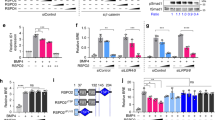Abstract
Intercellular signalling by Wnt morphogenetic proteins is subject to a multi-layered system of regulation. The four secreted R-spondin proteins potentiate Wnt signalling in vertebrates. They are involved in embryogenesis, adult stem cell biology and cancer progression and have been proven essential for ex vivo culturing of organoids. Recent research has generated profound new insights into how R-spondins function to stabilize Wnt receptors of the Frizzled family at the cell surface.
Similar content being viewed by others
Literatur
MacDonald BT, He X (2012) Frizzled and LRP5/6 receptors for Wnt/beta-catenin signaling. Cold Spring Harb Perspect Biol 4, doi: 10.1101/cshperspect.a007880
Janda CY, Waghray D, Levin AM et al. (2012) Structural basis of Wnt recognition by Frizzled. Science 337:59–64
Sato T, Vries RG, Snippert HJ et al. (2009) Single Lgr5 stem cells build crypt-villus structures in vitro without a mesenchymal niche. Nature 459:262–265
Glinka A, Dolde C, Kirsch N et al. (2011) LGR4 and LGR5 are R-spondin receptors mediating Wnt/beta-catenin and Wnt/PCP signalling. EMBO Rep 12:1055–1061
Carmon KS, Gong X, Lin Q et al. (2011) R-spondins function as ligands of the orphan receptors LGR4 and LGR5 to regulate Wnt/beta-catenin signaling. Proc Natl Acad Sci USA 108:11452–11457
de Lau W, Barker N, Low TY et al. (2011) Lgr5 homologues associate with Wnt receptors and mediate R-spondin signalling. Nature 476:293–297
Hao HX, Xie Y, Zhang Y et al. (2012) ZNRF3 promotes Wnt receptor turnover in an R-spondin-sensitive manner. Nature 485:195–200
Koo BK, Spit M, Jordens I et al. (2012) Tumour suppressor RNF43 is a stem-cell E3 ligase that induces endocytosis of Wnt receptors. Nature 488:665–669
Zebisch M, Xu Y, Krastev C et al. (2013) Structural and molecular basis of ZNRF3/RNF43 transmembrane ubiquitin ligase inhibition by the Wnt agonist R-spondin. Nat Commun 4:2787
Peng WC, de LW, Forneris F et al. (2013) Structure of stem cell growth factor R-spondin 1 in complex with the ectodomain of its receptor LGR5. Cell Rep 3:1885–1892
Chen PH, Chen X, Lin Z et al. (2013) The structural basis of R-spondin recognition by LGR5 and RNF43. Genes Dev 27:1345–1350
Wang D, Huang B, Zhang S et al. (2013) Structural basis for R-spondin recognition by LGR4/5/6 receptors. Genes Dev 27:1339–1344
Khan TN, Klar J, Nawaz S et al. (2012) Novel missense mutation in the RSPO4 gene in congenital hyponychia and evidence for a polymorphic initiation codon (p.M1I). BMC Med Genet 13:120
Author information
Authors and Affiliations
Corresponding author
Additional information
Matthias Zebisch 1998–2003 Biochemiestudium an der Universität Halle/Saale. 2008 Promotion am Biotechnologisch-Biomedizinischen Zentrum der Universität Leipzig; dort bis 2010 Postdoc. Seit 2011 Postdoc am Wellcome Trust Center for Human Genetics, Oxford, UK. 2011–2013 Marie Curie-IEF-Stipendiat.
E. Yvonne Jones 1985 Promotion in Molekularer Biophysik, Universität Oxford, UK. 1995–1991 Postdoc an den Universitäten Edinburgh und Oxford, UK. Seit 1991 Arbeitsgruppenleiterin an der Universität Oxford. 1999 Professor für Proteinkristallografie. Seit 2008 Leiterin der Abteilung Strukturbiologie (STRUBI) am Wellcome Trust Center for Human Genetics, Oxford.
Rights and permissions
About this article
Cite this article
Zebisch, M., Yvonne Jones, E. R-Spondine: Einblicke in die Potenzierung der Wnt-Signaltransduktion. Biospektrum 20, 395–399 (2014). https://doi.org/10.1007/s12268-014-0455-9
Published:
Issue Date:
DOI: https://doi.org/10.1007/s12268-014-0455-9




